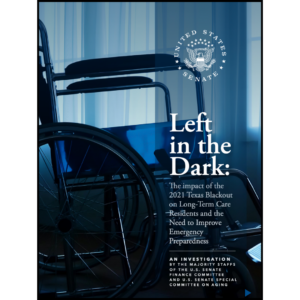‘Active shooter’ events: Balancing resident, staff safety
 This blog was co-authored by James Minninger, a security consultant with Sorensen, Wilder & Associates. A retired police sergeant in the suburbs of Philadelphia, he was an operator on SWAT, lead tactical firearms instructor and less lethal munitions operator. He is certified in basic and advanced SWAT operations, hostage rescue, basic and advanced weapons of mass destruction tactical operations and hostage negotiations.
This blog was co-authored by James Minninger, a security consultant with Sorensen, Wilder & Associates. A retired police sergeant in the suburbs of Philadelphia, he was an operator on SWAT, lead tactical firearms instructor and less lethal munitions operator. He is certified in basic and advanced SWAT operations, hostage rescue, basic and advanced weapons of mass destruction tactical operations and hostage negotiations.
Our previous blog focused on misconceptions associated with preparing for “active shooter” events and facility lockdown. This time, we’re focusing on some of the challenges in balancing resident and staff safety.
One of the most overlooked components in an active shooter response policy in a healthcare facility also is the main focus of your day-to-day routine: the care and well-being of your residents. As we noted previously, the traditional suggestion to survive an active shooter event, as outlined by the Department of Homeland Security, is the “run, hide, fight” doctrine, an approach that is sound but does not address a big challenge within the realm of long-term care: the well-being of the residents.
The mission statement and core values of your facility probably contain wording and ideology related to compassionate resident care. The active shooter policy for your facility also should consider that care. Although your active shooter response policy cannot dictate that staff members remain in the midst of an active shooter event to care for residents, leaving the residents to fend for themselves while staff members evacuate is not a sound idea either. So what are your options to balance staff and resident safety?
New tactics
After the Columbine High School shootings in 1999, where one teacher and 12 students were killed, police response and tactics in active shooter events changed nationwide. Police officers no longer surround the scene and wait for specialized units such as SWAT to arrive. They immediately enter the facility and look for the shooter, to stop the action. This newer strategy had two effects: 1) the quick response to the threat has helped the police save lives, and 2) an active shooter now has changed his or her tactics in response to the police officers’ rapid response.
An active shooter now needs to move rapidly through a facility, looking for targets of convenience and opportunity, because the shooter knows that police officers are coming. This action is evident in the surveillance video that the FBI released of shooter Aaron Alexis at the Washington, D.C., Navy Yard. Alexis moves rapidly, doesn’t stop to try to enter doors, and at the end of the video, quickly moves toward people he sees at the end of a long hallway.
The change in active shooter tactics because of rapid police intervention will help you survive an event. Let’s see how:
Your active shooter response needs to contain several layers dictated by the shooter’s location and actions. But what does that mean? Let’s look at the concept of “use of force” used by law enforcement officers.
Formerly, an officer’s use of force choice was guided by a clearly defined continuum: it started at the lowest level and progressively went up. For example, one of the lowest levels of force an officer could use was his or her mere presence in uniform. The police uniform and badge are recognized as symbols of authority and, by that officer being present, show a low level of force.
Force then progressed up from that—verbal, hands-on, pepper spray, Taser, strikes and so on—until the highest level, deadly force, or the use of an officer’s firearm. A progression of force application existed.
In the past decade, however, law enforcement has shifted the way it thinks about use of force and the continuum. Think of all law enforcement use-of-force options as tools. The action of the perpetrator dictates what tool a law enforcement officer uses (as long as it is reasonable and necessary).
For example, if a “bad guy” (or gal) is firing a gun at a police officer, should the officer start at the lowest levels of force, relying on mere presence and verbal commands, or can the police officer reach into his or her “toolbox” and go right to the force level of using a firearm? The obvious answer is to bypass all the lower levels of force and proceed to deadly force. The perpetrator’s actions have dictated the use of force used by the officer.
The same theory can be used in an active shooter response in long-term care. When the bad guy’s actions and location dictate your active shooter response, don’t over-think the concept. If the shooter is in the facility, away from your location, and the sound of gunfire is faint, what would your response be? If the bad guy is in eyesight but not close to your location, how would you respond? If the active shooter comes through the front door of your facility and you are in the lobby, what would you do? Remember that concept as we discuss the development of an active shooter safety action plan and the Safety Transition Adjustment Formula Protocol (STAF-P).
Action plan: Personal safety
In an active shooter event, we slightly modified the run, hide, fight approach adopted by the U.S. Department of Homeland Security. For ease of remembering, we call our active shooter safety action plan “the four outs.”
- Get out: This step is the equivalent of “run” in the run, hide, fight approach. If you can, quickly evacuate the facility. Leave personal belongings behind, and encourage others to go with you. Call 911 when you are in a safe location. Follow this course of action if the active shooter is not in your direct sight.
- Hide out: Hide in an inconspicuous area. Remember, the active shooter is looking for targets of convenience and opportunity. He or she does not have the time to search, because of the rapid and impending police response.
- Keep out: We added this step to the run, hide, fight protocol. It sounds simple and is based on commonsense, but if you do not have training and an advance plan, it may not occur to you. If you need to hide because the active shooter is nearby or blocking your egress, keep the shooter out of your hiding spot by barricading it. Doing so may be as simple as locking the door or pushing a piece of furniture in front of the door.
- Take out: This course of action is your last resort for survival in an active shooter event. “Take out” corresponds to the “fight” in the run, hide, fight doctrine. Use it when you can’t evacuate or hide. If you have to interact face-to-face with the active shooter, use weapons of opportunity, diversion and a committed action to attack him or her. Remember, there are no rules when it comes to fighting someone intent on killing you. In such a case, you truly are in a fight for your life.
Balancing resident, staff safety
Use STAF-P to balance the safety of both staff members and the people for whom they are tasked to care: the residents. Make, or have someone make, a facility-wide announcement at the beginning (or at the moment of recognition) of an active shooter event. Early recognition of an event, combined with a clear, concise announcement of the location of the shooter, will save lives. Staff members then will decide on a resident safety action plan or a personal safety action plan based on the shooter’s location. Visual confirmation and auditory clues—for instance, the sound of gunfire—will aid in the decision-making process.
If an announcement is made that the shooter is in the area of the main entrance and your personal care wing is on the second floor, several hundred feet from the last known location of the shooter, how many residents could you safely evacuate or hide? As the sound of gunfire gets louder and it is apparent that the shooter is ready to enter the personal care wing, transition from resident safety to personal safety (remember the four outs).
To whom do you attend first when focusing on resident safety? Use the same priority you would for fire evacuation:
- ambulatory residents,
- those with assistive devices,
- residents in wheelchairs, and then
- those who are bedridden.
Consider hiding immediately those who cannot evacuate due to the shooter’s location or the fact that they are bedridden or have other ailments or physical maladies.
Your facility must adopt a well-thought-out and thorough active shooter response policy that considers the safety of both residents and staff members. Everyone needs to understand the policy and be trained on through drills and exercises. Additional training considerations in active shooter response are crisis decision-making and stress inoculation.
Crisis decision-making, stress inoculation
If your facility has the misfortune of being the site of an active shooter event of any magnitude, lives will be lost unless you have provided staff members with training and tools. Active shooter training in long-term care must focus on rapid recognition of an active shooter event, stress inoculation and decision-making skills for staff, facility-wide communication and an announcement of the event, and the implementation of a safety action plan based on the movements of the offender.
Why are crisis decision-making skills and stress inoculation so important? If you have been working in the healthcare field for any amount of time, chances are high that you have participated in a cardiac or traumatic code or some other medical crisis that without immediate attention would have meant the imminent death of a patient or resident.
Do you recall how you reacted and performed during your first code? Without repetitive didactic and practical training in code response, chances are you would not have performed well; stress, anxiety and the chaos of the moment would have jeopardized the life of the victim. But because of proper repetitive training, you more than likely responded appropriately during the code.
The same can be said during an active shooter event. It will be chaotic, and it is your responsibility to control chaos for your safety and the safety of your residents.
No margin for failure
The likelihood of an active shooter event your facility is slim, albeit possible. As with every other possible crisis scenario, you must address an active shooter event in the phases of planning, response, mitigation and recovery. Much the same as fire plans, weather emergency plans, utility failure plans and other crisis plans, your active shooter plan must be exercised, evaluated, revised and retested to ensure that it serves your goals and that your staff members develop the needed competencies and proficiencies. Putting faith in the belief that “it won’t happen here” and allowing that mindset to replace planning and training reminds me of this well-known emergency preparedness adage: “Failing to prepare is preparing to fail.” Unfortunately, in an active shooter scenario, no margin for failure exists.
This is the second in a series of blogs about active shooter evenets. See Part 1: Preparing for 'active shooter' events: Lockdowns.

Steve Wilder, CHSP, STS, is president and chief operating officer of Sorensen, Wilder & Associates (SWA), a healthcare safety and security consulting group based in Bourbonnais, Ill. SWA performs workplace safety compliance audits and security vulnerability assessments in all types of healthcare facilities. Wilder can be reached at (800) 568-2931 or swilder@swa4safety.com.
Related Articles
Topics: Disaster Preparedness , Executive Leadership , Facility management , Leadership , Risk Management











